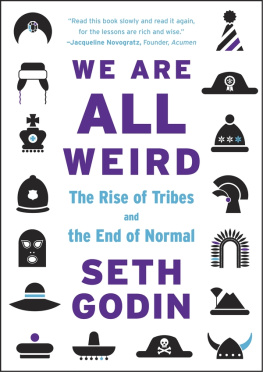The author and publisher have provided this e-book to you for your personal use only. You may not make this e-book publicly available in any way. Copyright infringement is against the law. If you believe the copy of this e-book you are reading infringes on the authors copyright, please notify the publisher at: us.macmillanusa.com/piracy.
In 2006, I unwittingly set off down the path leading to this book when I moved from the Department of Anthropology at Emory University to the University of British Columbia (UBC) in Vancouver, where I became a professor in the Departments of both Psychology and Economics. This was indeed an unlikely port of call, since Id never taken a course in either field. Soon after arriving at UBC, two seemingly independent developments laid the foundation for this book. First, the Head of the Department of Economics, Anji Redish, suggested that I might teach a course called The Wealth and Poverty of Nations to fulfill my teaching obligation in the department. Shed noticed that when I was a graduate student at UCLA, I had taught a seminar based on Jared Diamonds book Guns, Germs, and Steel. This teaching opportunity led me deep into the literature in economics on why countries differ in prosperity, and why the Industrial Revolution occurred in Europe but not elsewhere. Topically, this research naturally fit my long-running anthropological interest in the evolution of human societies, although anthropologists usually didnt try to explain things that occurred after the rise of ancient states. Economists, by contrast (at that time), rarely looked back more than about 500 years from the present. Each time I taught the course, I modified the readings, which provided me with a chance to explore and critique the field. While this was fun, I didnt realize just how important this knowledge would be to my ongoing efforts to understand human psychological variation.
The second important development arose as I got to know two UBC social psychologists, Ara Norenzayan and Steve Heine. Ara, an Armenian who had emigrated from war-torn Lebanon to Fresno, California, when he was 18 years old, had spent the early part of his scientific career studying cultural differences in perception, thinking styles, and reasoning. Steve, whose research was (I suspect) often inspired by interactions with his Japanese wife, had been comparing how Canadians and Japanese think about themselves in relation to others and how that affects their motivations, decision-making, and sense of self. Independently, all three of us had noticedwithin our separate domains of expertisethat Western populations were often unusual when compared to two or more other populations. Over Chinese takeout, in a basement food court where the famed psychologists Daniel Kahneman and Amos Tversky had purportedly hatched their plans to examine rational decision-making, we decided to compile all the cross-cultural studies that we could locate on important aspects of human psychology. After carefully reviewing all the research that we could locate, we arrived at three striking conclusions:
- Massively biased samples: Most of what was known experimentally about human psychology and behavior was based on studies with undergraduates from Western societies. At the time, 96 percent of experimental participants were drawn from northern Europe, North America, or Australia, and about 70 percent of these were American undergraduates.
- Psychological diversity: Psychological differences between populations appeared in many important domains, indicating much greater variation than one might expect from reading the textbooks or major journals in either psychology or behavioral economics.
- Psychological peculiarity: When cross-cultural data were available from multiple populations, Western samples typically anchored the extreme end of the distribution. They were psychologically weird.
Taken together, these three findings meant that almost everything wescientistsknew about human psychology derived from populations that seemed to be rather unusual along many important psychological and behavioral dimensions. Crucially, there was no obvious way to tell whether a psychological pattern found in Western undergraduates would hold cross-culturally, since existing research going back over a half century had revealed differences across populations in peoples susceptibility to visual illusions, spatial reasoning, memory, attention, patience, risk-taking, fairness, induction, executive function, and pattern recognition.
Four years after our lunch in the basement, Ara, Steve, and I finally published The weirdest people in the world? in the journal Behavioral and Brain Sciences (2010), along with a commentary in Nature magazine. In these publications, we dubbed the populations so commonly used in psychological and behavioral experiments as W.E.I.R.D. because they came from societies that are Western, Educated, Industrialized, Rich, and Democratic. Of course, we suspected there was likely important psychological variation among Western populations and within Western countries, but even this variation wasnt showing up very often in published studies or textbooks.
Although our publication in Behavioral and Brain Sciences did succeed in highlighting the narrowness of sampling within the psychological and behavioral sciences, Ive always found it unsatisfying, because it doesnt explain anything. How can we account for all this psychological variation? And why are WEIRD people so unusual? In fact, without guiding theories or explanations, we couldnt even be sure that WEIRD people were indeed unusual. We wondered if WEIRD researcherswho entirely dominate the relevant scientific disciplinesmight have unknowingly gravitated toward those aspects of psychology or behavior on which they themselvestheir populationswere likely to stand out. Steve wondered aloud at lunch about what Japanese psychology might look like if Japanese researchers had developed their own version of this discipline, without first importing Western concepts, interests, and emphases.
In the aftermath of our paper, my mental gears began to turn on the question of how to explain the broad patterns of psychological variation that Ara, Steve, and I had discerned. The current effort documents my progress to date. However, in constructing this book, I ended up first producing another book, called The Secret of Our Success (2016). Originally, the ideas that I developed there were supposed to form Part I of this book. But, once I opened that intellectual dam, a full book-length treatment flooded out, and nothing could stop it. Then, with The Secret of Our Success tempered and ready, I could confidently synthesize the elements necessary for this book. Thanks to my publisher, Farrar, Straus and Giroux, for understanding that sometimes you need to forge the proper tools before tackling a big job.
This project required me to draw on and integrate research from across the social and biological sciences, and for that I had to rely on a vast network of friends, colleagues, and fellow scientists who pitched in with their knowledge, wisdom, and insights over a decade. I could never thank everyone who helped me, in countless conversations and emails.
As a wayward cultural anthropologist who washed up on the academic shores of psychology and economics at the University of British Columbia, Id like to thank the truly amazing group of scholars and friends there who took me in. The contributions of Steve and Ara were, of course, foundational. I also learned a tremendous amount from Ted Slingerland, Patrick Francois, Siwan Anderson, Mauricio Drelichman, Ashok Kotwal, Kiley Hamlin, Mark Schaller, Mukesh Eswaran, Jessica Tracy, Darrin Lehman, Nancy Gallini, Andy Baron, Sue Birch, and Janet Werker. Special thanks to Siwan and Patrick for providing comments on my draft chapters.














